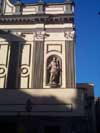|
|
|
 2nd
STAGE 2nd
STAGE
From Piazza San Gaetano to the Gerolomini
From
this point, the walk continues to the intersection with via Duomo
amid shops and religious buildings of great historical and artistic
interest. Along the route, as well, are many private dwellings as
well as the imposing larger structures of the basilica of San Paolo
Maggiore and that of San Lorenzo Maggiore, located on the site of
the ancient Roman forum. The former, San Paolo Maggiore, now presents
a 17th-century soaring double staircase that dominates the entire
square; the church, itself, goes back to the 8th century and was
built on the remains of the ancient temple to Castor and Pollux,
from which structure a few Corinthian columns have been conserved.
Thus, the church has paleo-Christian origins; in the first half
of the 1500s it was entrusted to and cared for by clergy who enlarged
the transept and central portion of the church including the naves,
lateral chapels, and facade (to a design by Guglielminelli) such
that the facade now incorporates two columns of the ancient temple.
| |
 The latter structure, San Lorenzo, across the square, is where tradition
says that Boccaccio first met Fiametta, but the true historical
importance of the church comes from archaeological discoveries beneath
the courtyard of the monastery, itself. The site was given to the
Franciscan order, and the church was then built at the end of the
1200s and beginning of the 1300s on the ruins of a paleo-Christian
church from the 6th century, which ruins were only discovered by
later archaeology beneath the church and monastery. The main hall
of the church presents a trussed covering and lateral chapels of
northern-European influence, evidenced by the ribbed vaults. The
facade is from 1742 and is the work of Ferdinando Sanfelice and
conserves the Angevin marble portal. The original belfry survived
until 1456 when it was toppled by an earthquake and replaced by
the one seen today. Within the church there are fine wooden crosses
from the 1300s, multi-panel terracotta displays from the 1500s,
the sepulcher of Catherine of Austria (the work of Tino da Camaino),
and polychrome marble statuary of Cosimo Fanzago, who helped design
the chapels for the gentry as did Mattia Preti the larger chapel
of Sant'Antonio. From the central courtyard, there is access to
the excavated site--that is, the forum, the shops and secondary
Greco-Roman structures of the macellum, the marketplace of
the ancient city.
The latter structure, San Lorenzo, across the square, is where tradition
says that Boccaccio first met Fiametta, but the true historical
importance of the church comes from archaeological discoveries beneath
the courtyard of the monastery, itself. The site was given to the
Franciscan order, and the church was then built at the end of the
1200s and beginning of the 1300s on the ruins of a paleo-Christian
church from the 6th century, which ruins were only discovered by
later archaeology beneath the church and monastery. The main hall
of the church presents a trussed covering and lateral chapels of
northern-European influence, evidenced by the ribbed vaults. The
facade is from 1742 and is the work of Ferdinando Sanfelice and
conserves the Angevin marble portal. The original belfry survived
until 1456 when it was toppled by an earthquake and replaced by
the one seen today. Within the church there are fine wooden crosses
from the 1300s, multi-panel terracotta displays from the 1500s,
the sepulcher of Catherine of Austria (the work of Tino da Camaino),
and polychrome marble statuary of Cosimo Fanzago, who helped design
the chapels for the gentry as did Mattia Preti the larger chapel
of Sant'Antonio. From the central courtyard, there is access to
the excavated site--that is, the forum, the shops and secondary
Greco-Roman structures of the macellum, the marketplace of
the ancient city.
|
 The
second section of the decumanus maior ends at piazza Gerolomini
and the church of Santa Maria della Colonna and the 16th-century church
of the Gerolomini (also called San Filippo), which since 1592 has
occupied a two-block section on the grid of the Greco-Roman city between
the central decumanus and the upper one ( now via Anticaglia). The
second section of the decumanus maior ends at piazza Gerolomini
and the church of Santa Maria della Colonna and the 16th-century church
of the Gerolomini (also called San Filippo), which since 1592 has
occupied a two-block section on the grid of the Greco-Roman city between
the central decumanus and the upper one ( now via Anticaglia). |
| previous
page - II stage |
|
Photos:
Jeff Matthews |
|
|
